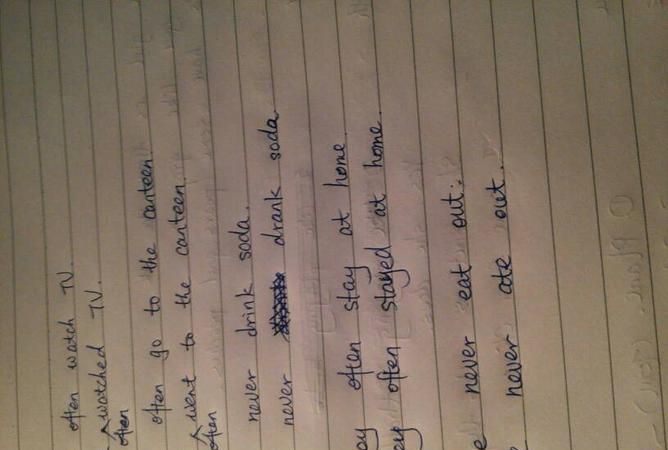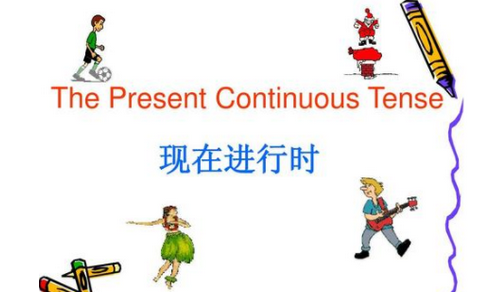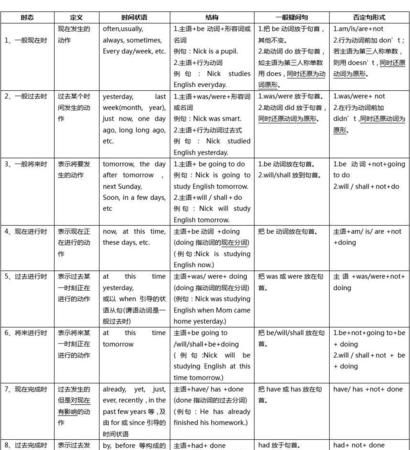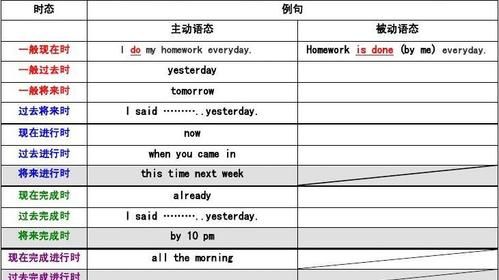本文目录
一般现在时的结构和造句
一般现在时(Simple present tense)。表示通常性、规律性、习惯性、真理性的状态或者动作(有时间规律发生的事件)的一种时间状态。
1.肯定句构成:主语+动词 (注意人称变化) +其它成分
I have a pen.
我有一支笔。
The sky is blue。
天空是蓝的。
she is a good girl.
她是个好女孩。
2.否定句构成:
行为动词的否定句:主语+助动词(do/does) + not +动词原形+其它成分
He dosen’t have a dog.
他没有养狗。
He isn’t young.
他并不年轻。
We don’t like that dog
我们不喜欢那只狗。
3.一般疑问句:
A.行为动词的一般疑问句:助动词(do/does)+主语+动词原形 + 其它成分
Do you like it?
你喜欢吗?
Yes, I do. / No. I don’t .
是的,我喜欢。不,我不喜欢 。
Does he(she) like it?
他(她)喜欢吗?
Yes, he( she )does. / No, he ( she )doesn’t.
是的,他(她)喜欢/不是,他(她)不喜欢
B. 动词BE 的一般疑问句Am / Is /Are +主语 + 其它成分
Are you a teacher?
你是老师吗?
Yes, I am. / No, I am not.
是的,我是。/不,我不是。
Are they students of your school.
他们是你学校的学生吗?
Yes they are / No they aren,t.
是的,他们是。/不是,他们不是。
4.特殊疑问句:特殊疑问词 + 一般疑问句
How many students are there in your school?
你的学校有多少个学生?
What do you usually do on Sunday?
他们星期天通常做什么?

英语用现在进行时造句至少10句及翻译
答案如下:
1.I am eating now.
译文:我在吃饭。
2.I am running now.
译文:我正在跑步。
3.I am sitting bihind you.
译文:我正坐在你后面。
4.He is sleeping now.
译文:他正在睡觉。
5.He is sitting in front of you.
译文:他正坐在你前面。
6.She is driving now.
译文:她正在开车。
7.My sister is swimming now.
译文:我妹妹正游泳。
8.My mother is running to you.
译文:我妈妈正跑向你。
9.My brother is sitting among us.
译文:我哥哥正坐在你我中间。
10.My father is planting flowers.
译文:我父亲正在种花。
11.She is flying a kate.
译文:她正放风筝。
12.He is playing the piano.
译文:他正弹钢琴。
13.He is playing basketball.
译文:他正打篮球。
14.She is cycling.
译文:她正骑自行车。
15.They are skating now.
译文:他们正在滑雪。
扩展资料
一、现在进行时的定义:
现在进行时是英语的一种时态,表示现在进行的动作或存在的状态。在英语时态中,“时“指动作发生的时间,”态“指动作的样子和状态。现在进行时表示动作发生的时间是“现在”,动作目前的状态是“正在进行中”。
二、现在进行时的含义:
1.表示现在正在进行的动作。
2.表示现阶段正在进行或从事的动作。
三、现在进行时的使用场合:
1.当句中出现的表示时间的词是now,at the moment,;(此刻、现在)等时,表示句子要说明的是现在正在发生的事,动词应用现在进行时。
2.当句中出现的时间状语是these days,this week,this month,this term 等时,如果句子所要表达的意义是在这一阶段正在发生的事,则动词应用现在进行时。
3.在句中出现了Look,Listen,Can't you see? 等暗示词时,说明后面谓语动词的动作正在发生,该动词应用现在进行时。
4.注意根据上下文的暗示,句子的谓语动词可能应用现在进行时。
5.现在进行时态表将来,主要用于表示按计划或安排要发生的动作。
用各种时态造句各10句
一、 一般现在时:
1.概念:经常、反复发生的动作或行为及现在的某种状况。
2.时间状语: always, usually, often, sometimes, every week (day, year, month…), once a week, on Sundays,
3.基本结构:动词 原形 (如主语为第三人称单数,动词上要改为第三人称单数形式)
4.否定形式:am/is/are+not;此时态的谓语动词若为行为动词,则在其前加don't,如主语为第三人称单数,则用doesn't,同时还原行为动词。
5.一般疑问句:把be动词放于句首;用助动词do提问,如主语为第三人称单数,则用does,同时,还原行为动词。
6.例句:. It seldom snows here. (it doesnot)(dose it或者isnot it?口语)
He is always ready to help others. (he is not )(is he ?)
Action speaks louder than words.
二、 一般过去时:
1.概念:过去某个时间里发生的动作或状态;过去习惯性、经常性的动作、行为。
2.时间状语:ago, yesterday, the day before yesterday, last week,last(year, night, month…), in 1989, just now, at the age of 5, one day, long long ago, once upon a time, etc.
3.基本结构:be动词;行为动词 的过去式
4.否定形式:was/were+not;在行为动词前加didn't,同时还原行为动词。
5.一般疑问句:was或were放于句首;用助动词do的过去式did 提问,同时还原行为动词。
6.例句:She often came to help us in those days.
I didn't know you were so busy.
三、 现在进行时:
1.概念:表示现阶段或说话时正在进行的动作及行为。
2.时间状语:now, at this time, these days, etc.
3.基本结构:am/is/are+doing
4.否定形式:am/is/are+not+doing.
5.一般疑问句:把be动词放于句首。
6.例句: How are you feeling today?
He is doing well in his lessons.
四、 过去进行时:
1.概念:表示过去某段时间或某一时刻正在发生或进行的行为或动作。
2.时间状语:at this time yesterday, at that time或以when引导的谓语动词是一般过去时的时间状语等。
3.基本结构:was/were+doing
4.否定形式:was/were + not + doing.
5.一般疑问句:把was或were放于句首。
6.例句:At that time she was working in a PLA unit.
When he came in, I was reading a newspaper.
五、 现在完成时:
1.概念:过去发生或已经完成的动作对现在造成的影响或结果,或从过去已经开始,持续到现在的动作或状态。
2.时间状语:recently, lately, since…for…,in the past few years, etc.
3.基本结构:have/has + done
4.否定形式:have/has + not +done.
5.一般疑问句:have或has。
6.例句:I've written an article.
The countryside has changed a lot in the past few years.
六、 过去完成时:
1.概念:以过去某个时间为标准,在此以前发生的动作或行为,或在过去某动作之前完成的行为,即“过去的过去”。
2.时间状语:before, by the end of last year(term, month…),etc.
3.基本结构:had + done.
4.否定形式:had + not + done.
5.一般疑问句:had放于句首。
6.例句:As soon as we got to the station, the train had left.
By the end of last month. We had reviewed four books
七、 一般将来时:
1.概念:表示将要发生的动作或存在的状态及打算、计划或准备做某事。
2.时间状语:tomorrow, next day(week, month, year…),soon, in a few minutes, by…,the day after tomorrow, etc.
3.基本结构:am/is/are/going to + do;will/shall + do.
4.否定形式:was/were + not; 在行为动词前加didn't,同时还原行为动词。
5.一般疑问句:be放于句首;will/shall提到句首。
6.例句:They are going to have a competition with us in studies.
It is going to rain.
八、 过去将来时:
1.概念:立足于过去某一时刻,从过去看将来,常用于宾语从句中。
2.时间状语:the next day(morning, year…),the following month(week…),etc.
3.基本结构:was/were/going to + do;would/should + do.
4.否定形式:was/were/not + going to + do;would/should + not + do.
5.一般疑问句:was或were放于句首;would/should 提到句首。
6.例句:He said he would go to Beijing the next day.
I asked who was going there .
九.将来完成时:
1.概念:在将来某一时刻之前开始的动作或状态
2.时间状语:by the time of;by the end of+时间短语(将来);by the time+从句(将来)
3.基本结构:be going to/will/shall + have done
十.现在完成进行时:
1.概念:在过去某一时刻之前开始的动作或状态一直持续到说话为止
2.基本结构:have/has +been+doing
几种常见时态的相互转换
英语中的几种时态在一定情况下可以互相转换,以下是几种常见的转换形式:
十一、 一般过去时与现在完成时的转换
在现在完成时中,延续性动词能与表示一段时间的状语连用,瞬间动词却不能。但是,可用别的表达方式:①瞬间动词用于“一段时间 + ago”的一般过去时的句型中;②瞬间动词可改成与之相对应的延续性动词及短语,与一段时间连用;③瞬间动词用于“It is + 一段时间 + since + 一般过去时”的句型中,表示“自从……以来有……时间”的意思,主句一般用it is来代替It has been;④瞬间动词用于“Some time has passed since + 一般过去时”的句型中。请看:
A. He joined the League two years ago.
B. He has been in the League for two years.
C. It is two years since he joined the League.
D. Two years has passed since he joined the League.
十二、 一般现在时与现在进行时的转换
在一般现在时中,at加上名词表示“处于某种状态”,如at work(在工作), at school(上学、上课)等。此短语可与进行时态转换。请看:
Peter is at work, but Mike is at play.
Peter is working, but Mike is playing.
十三、 现在进行时与一般将来时的转换
在现在进行时态中go, come, leave, start, arrive等动词常与表示将来的时间状语连用表示将要发生的动作。如:I am coming, Mum! 意为“我就来,妈妈!”请看:
The train is leaving soon.
The train will leave soon.

用四种时态各造5个句子英语
①一般现在时态(5句)I leave home for school at 7 every morning.
The earth moves around the sun.
Shanghai lies in the east of China.Ann Wang writes good English but does not speak well.
The train starts at 10 o'clock in the morning.②一般过去时态(5句) I went to the zoo yesterday.
I stayed up last night ..
This morning , I got up early , went out for a walk , then came back and cooked for my family
He worked in the store for 5 years.
I used to get up early. ③现在进行时态(5句)We are waiting for you.
Mr. Green is writing another novel.
She is learning piano under Mr. Smith.
The leaves are turning red.
It's getting warmer and warmer.
④一般将来时态(5句)Are we to go on with this work?我们继续干吗?
The boy is to go to school tomorrow.这个男孩明天要去上学。
We are about to leave.我们马上就走。
The meeting starts at five o'clock.会议五点开始。
He gets off at the next stop.他下一站下车

以上就是关于用各种时态造句各0句 ,一般现在时的结构和造句的全部内容,以及用各种时态造句各10句 的相关内容,希望能够帮到您。

